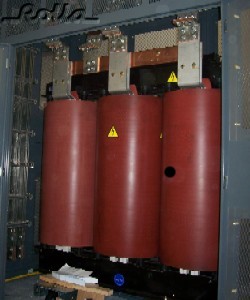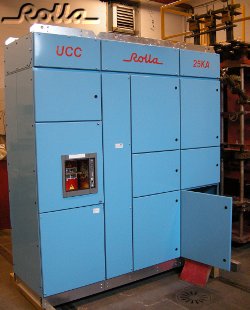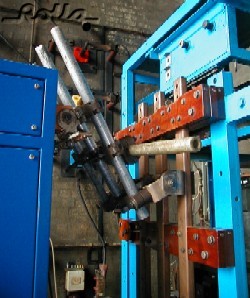Fault Ratings
Electrical Enclosures containing busbars, of the type manufactured by Rolla, are normally assigned a fault rating or short circuit rating. This is a brief and simple introduction to the concepts involved.
All our products are designed, tested and manufactured in accordance with the international standard BS EN IEC 61439-2:2021 (and general rules BS EN IEC 61439-1:2021). This standard defines a short circuit current as "overcurrent resulting from a short circuit due to a fault or an incorrect connection in an electric circuit" (Clause 3.8.6). In the case of a typical switchboard or motor control centre, the resulting short circuit current can be very large therefore the busbar system and supporting structure must be strong enough to withstand the effects without itself failing.
Typical HV/LV transformer as part of a package substation:-

Most of our products are connected to a 3 phase grid system, fed via a step-down transformer. In the UK this will often be from the 11kV local network (11,000V), down to 400V nominal (traditionally 415V in the UK). The size of the transformer will be determined by the required load, which will in turn determine the prospective fault magnitude. The table below shows some typical transformer sizes, associated loads and prospective 3 phase (symmetrical) fault levels. (Approximate values only).
| Transformer size (kVA) |
Typical Load (A) |
Typical Fault Level (A) |
| 315 |
400 |
8000 |
| 500 |
630 |
14000 |
| 800 |
1000 |
22000 |
| 1000 |
1250 |
28000 |
| 1250 |
1600 |
35000 |
| 1500 |
2000 |
41000 |
| 2000 |
2500 |
55000 |
| 2500 |
3200 |
69000 |
| 3000 |
4000 |
83000 |
As can be seen from the table, an MCC with a maximum load of up to 1000A, has to be able to withstand up to 22,000A in the event of a short circuit fault.
A simple rule of thumb guide to work out transformer currents is to multiply the kVA * 1.4 and then round down to nearest standard rating = typical full load (this is assuming typical UK conditions, 400V three phase). Fault levels depend on many factors but again a good rule of thumb is to assume transformer impedance at 5% so multiplying full load * 20 is a starting point.
Boards further down the network (not fed directly off the grid) will be different and in all cases a proper protection study will be required. The above are just round numbers but can be useful as a sanity check.
Under fault conditions (external faults), there are 2 major effects which the system has to withstand :-
1. The magnetic effects which translate into mechanical forces, and
2. The thermal effects due to the high current causing a rise in busbar temperature.
Magnetic effects act on the busbars themselves, and between the busbars and the surrounding steelwork. There is an initial "hit", at the start of the fault, called a peak, and then successive hits at the system fequency (50 cycles per second i.e. 50Hz in the UK). All this happens very fast, and the forces involved are often large enough to break welds or shear bolts, hence the need to test. It is false to assume bolting a tested busbar system into a steel enclosure will be sufficient, the whole system must be tested as an assembly (see below for description of earth bars).
Assembly under test:-

In normal circumstances, it is expected that the protective device (fuse or circuit breaker) will act to disconnect the supply in the event of such a fault. The switchgear, however, still has to carry the fault for a short time in order to allow the protective device to operate. Modern protective systems will normally operate very quickly and an Air Circuit Breaker, for instance, should clear a large fault in around 50ms (0.05 Seconds). Historically this was not always the case, and even today we assume a large safety margin by testing the switchboard for a fault rating withstand of 1 second.
Rolla standard values for short circuit ratings tests are:-
- 25kA for 1 second (eg UCC product, 400A to 1000A)
- 26kA for 1 second
- 50kA for 1 second (traditionally very popular in UK)
- 50kA for 3 seconds
- 80kA for 1 second
- 100kA for 1 second
In all cases the neutral and earth bars are also tested but at 60% of the above ratings due to the lower single phase voltages they are subjected to.
See here for our range of systems available.
Connections from test board to short circuit test station:-

The effects of such large currents are proportional to the square of the current, meaning that for a doubling of current, the effect is quadroupled. This is why you cannot extrapolate test results outside the values which have been tested. For example, it is often believed that if a board is tested with 1000A bars at 22kA, fitting 2000A bars should increase the capability to 44kA. This is not the case and it is always necessary to carry out a test for increased fault rating as the effects are multiplied by 4. Put another way, the hammer-blow effect which tries to break the system is now 4 times the magnitude and has not been proven unless tested.
One of the most difficult faults to deal with is a short circuit to earth (single phase fault). In this case the fault current will return through the earth bar and also the steelwork of the cubicle. If the structure is not strong enough, or if the fixings are not substantial, the earth bar will become detached and the fault may not be cleared leaving a very dangerous situation. All Rolla earth bar systems (main and dropper bars) are tested at the same time as the phases for a single phase fault condition thus ensuring total system integrity.